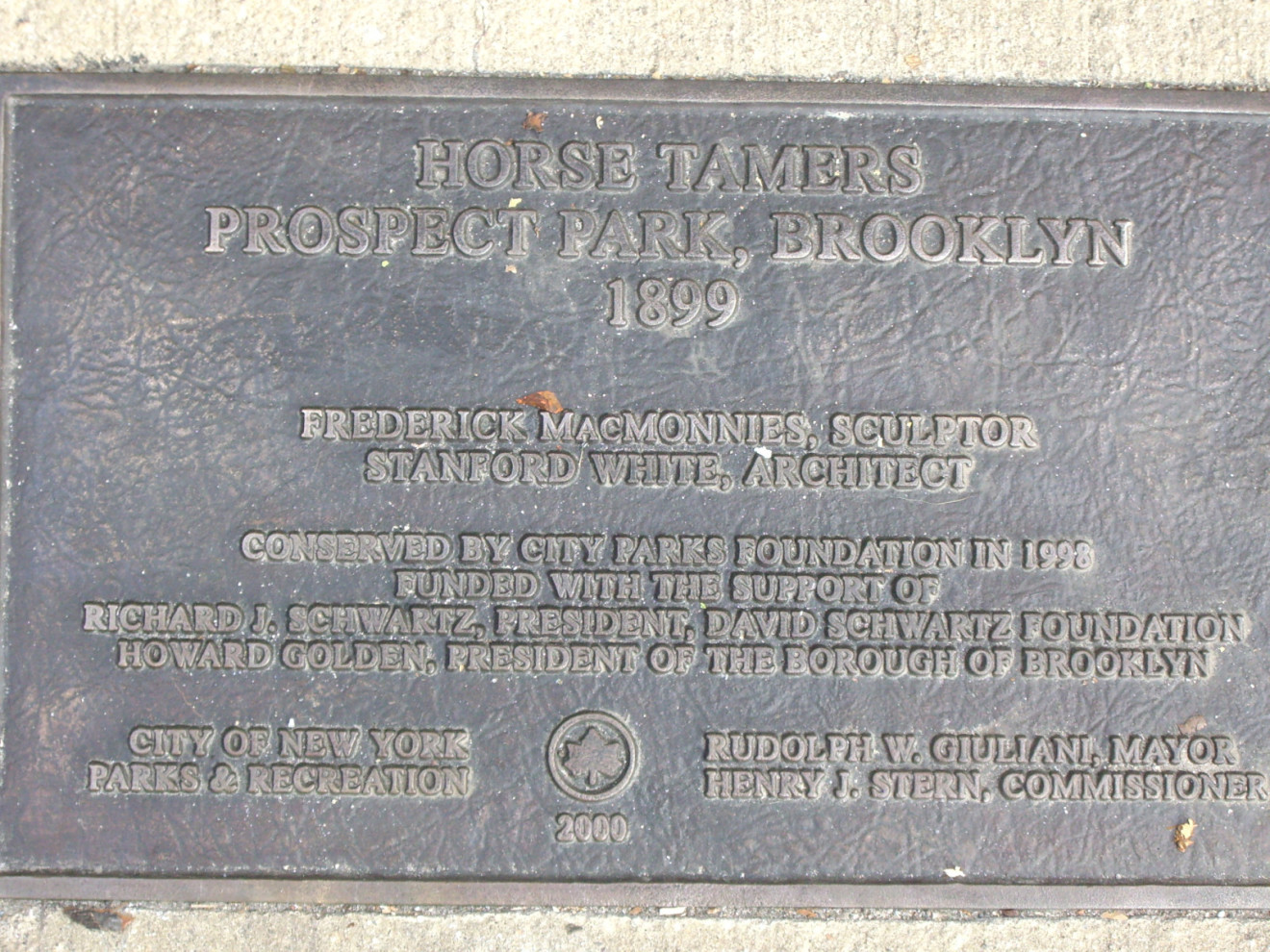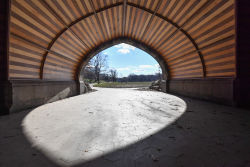Prospect Park
View all monuments in NYC Parks, as well as temporary public art installations on our NYC Public Art Map and Guide.
The Horse Tamers
| Artist: | Frederick William MacMonnies |
| Dedicated: | 1899 |
| Location: | Coney Island Avenue at Park Circle Entrance |
Artwork History
The Horse Tamers, by Frederick MacMonnies (1863-1937), is one of many sculpture groups in the outdoor collection of New York City’s parks. Dedicated in 1899, the Horse Tamers flank the Park Circle Entrance of Prospect Park.
In the 1890s, the eminent architect Stanford White (1853-1906) devised a plan to enhance Prospect Park and its environs with sculpture. White was guided in his plan by the concept of ennobling Brooklyn in the style of Paris and its monuments. MacMonnies was the principal sculptor. His Army and Navy groups (1901 and 1902, respectively) on the Soldiers and Sailors Memorial Arch in Grand Army Plaza are derived from François Rude’s high-relief sculptures on the piers of Paris’s Arc de Triomphe. The quadriga, or four-horse chariot (1898), atop the arch echoes the horses by Bosio on the Arc de Triomphe du Carrousel.
White and MacMonnies had previously collaborated on the altar of the Paulist Fathers’ Church of St. Paul, on Amsterdam Avenue in Manhattan and on City Hall Park’s Nathan Hale statue. Though MacMonnies was a Brooklyn native, his studio was in Paris, and his pieces were cast in France. MacMonnies’s connections to Brooklyn won him the support of Brooklyn Parks Commissioner Frank Squier and of General John B. Woodward, a wealthy Brooklynite and influential civic leader. When the Horse Tamers was installed, the local press commented, “MacMonnies is a Brooklyn boy, who went to Paris some years ago to study, and by general consent stands today in the very first rank of sculptors.”
White selected MacMonnies for the Horse Tamers commission in 1894. White included tile-roofed pavilions, curving benches, and decorative granite urns in his overall formal reconfiguration of this entrance to the park. The elaborate pedestals he designed are articulated with carved lion heads on the north and south faces, inset serpentine marble panels, and bronze swags, rosettes, and egg-and-dart moldings. The south faces have carved eagles under the cornices, and shields surrounded by laurel wreaths on the shafts.
Horse Tamers is an allegory of the Triumph of Mind over Brute Strength. The sculptures depict nude young men riding bareback on rearing, unbridled horses. To achieve their great dynamic energy, MacMonnies sculpted the horses after live Andalusian models. The full-scale plaster models (no longer extant) were exhibited to great acclaim in the Parisian Salon of 1898 and at the Universal Exposition of 1900. One of the bronze statues was damaged in shipping, then lost in a shipwreck off Newfoundland. Recovered and repaired by MacMonnies, both sculptures were unveiled in 1899. A century later, the sculptures were fully restored by the City Parks Foundation Monuments Conservation Program, with support from Richard J. Schwartz, President of the David Schwartz Foundation, and Brooklyn Borough President Howard Golden.
Artwork Details
| Description: | Two groups, each consisting of two horse figures and one mounted male figure, on two pedestals |
| Architect: | Stanford White |
| Materials: | Bronze, granite |
| Dimensions: | North group H: 16' W: 6'8" D:10'10"; South group H: 17' W: 6'8" D: 10'9½"; Each pedestal H: 20' W: 11'6" D: 17'6" |
| Foundry: | LeBlanc Barbedienne |
| Cast: | 1898 |
Inscription
1) "FREDERICK MAC MONNIES SCVLPr. 1898"2) "MAC-MONNIES SCVLPTEVR 1898"
Please note, the NAME field includes a primary designation as well as alternate namingsoften in common or popular usage. The DEDICATED field refers to the most recent dedication, most often, butnot necessarily the original dedication date. If the monument did not have a formal dedication, the yearlisted reflects the date of installation.
For more information, please contact Art & Antiquities at (212) 360-8163.
Check out your park's Vital Signs
Clean & Safe
Green & Resilient
Empowered & Engaged Users
Share your feedback or learn more about how this park is part of a
Vital Park System


















